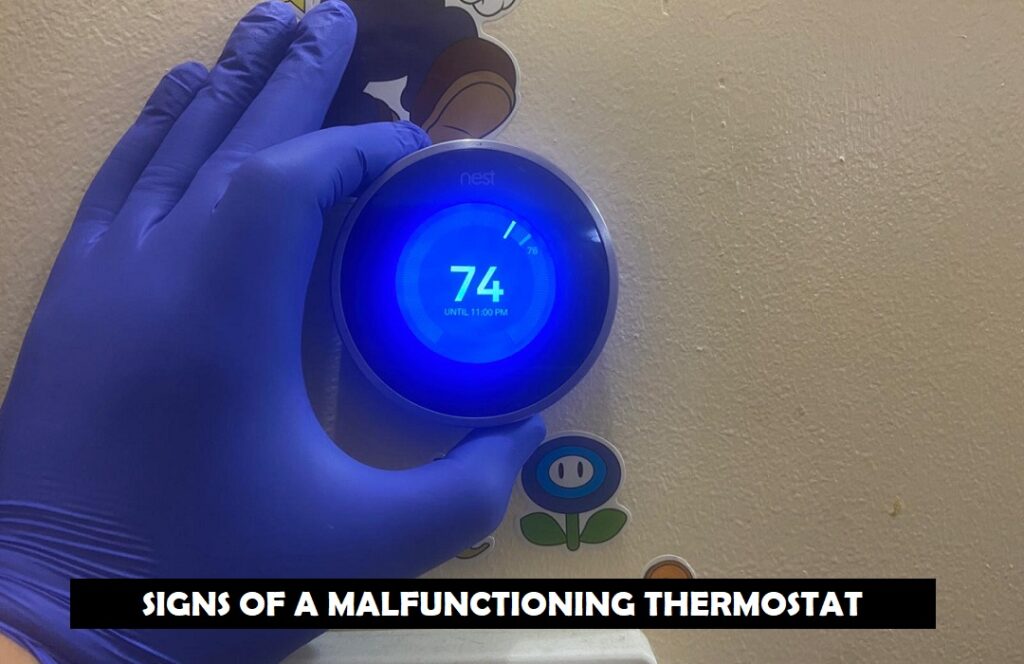A malfunctioning thermostat can wreak havoc on your home’s comfort and energy efficiency. It’s a small device with a big responsibility – regulating the temperature of your heating and cooling systems. When it doesn’t function properly, it can lead to discomfort, energy wastage, and even potential damage to your HVAC system. In this article, we will explore the signs that indicate your thermostat may be malfunctioning, helping you identify and address the issue promptly.

Understanding the Thermostat’s Role
Before we delve into the signs, it’s essential to understand the role of a thermostat. It serves as the control center for your heating and cooling systems, ensuring your home stays at the desired temperature. Thermostats come in various types, including manual, programmable, and smart thermostats, but they all share the same basic function – regulating temperature.
Signs of a Malfunctioning Thermostat
1. Inaccurate Temperature Reading
One of the most obvious signs of a malfunctioning thermostat is an inaccurate temperature reading. If your thermostat displays a significantly different temperature from what you’re experiencing in your home, it’s a clear indicator that something is amiss.
2. Temperature Fluctuations
Another common sign is frequent and erratic temperature fluctuations. Your HVAC system should maintain a relatively stable temperature. If it’s constantly turning on and off, your thermostat might be to blame.
3. Unresponsive Controls
When your thermostat becomes unresponsive to your adjustments or fails to turn your HVAC system on or off as instructed, it’s a sign of trouble. This can lead to wasted energy and discomfort.
4. Delayed Response
A properly functioning thermostat should respond promptly to changes in settings. If there is a noticeable delay in your HVAC system’s reaction to your thermostat adjustments, it’s a sign that the thermostat is not functioning correctly.
5. Short Cycling
Short cycling occurs when your HVAC system frequently turns on and off in rapid succession. This can cause wear and tear on the system and increase your energy bills. A malfunctioning thermostat can trigger short cycling.
6. Constantly Running System
On the flip side, if your heating or cooling system runs continuously without reaching the set temperature, your thermostat might not be signaling it to shut off when needed.
7. No Display
If your thermostat’s display is blank, it could indicate a power issue or a malfunction within the thermostat itself.
8. Incorrect Programming
For programmable thermostats, incorrect programming can lead to temperature inconsistencies. Check the settings and ensure they align with your preferences.
9. Loose Wiring
Loose or corroded wiring behind your thermostat can disrupt its functionality. Inspect the connections to rule out this issue.
10. Clicking Sounds
Unusual clicking or popping sounds from your thermostat could signify internal problems. It’s best to have it inspected by a professional.
11. High Energy Bills
A malfunctioning thermostat can cause your HVAC system to run inefficiently, leading to higher energy bills. If you notice a sudden spike in your utility costs, it’s worth investigating your thermostat’s condition.
12. HVAC System Shortage
In some cases, a malfunctioning thermostat can lead to an inadequate supply of heated or cooled air throughout your home, causing certain areas to remain uncomfortable.
13. Age of the Thermostat
If your thermostat is old and outdated, it may be prone to malfunctions. Consider upgrading to a modern, energy-efficient model.
14. Inconsistent Room Temperatures
If you have significant temperature differences between rooms, your thermostat may not be distributing the conditioned air evenly.
15. Erratic Fan Operation
The thermostat controls the fan operation as well. If the fan behaves erratically, it might be time to check the thermostat.
A malfunctioning thermostat can disrupt your home’s comfort and increase energy costs. If you notice any of these signs, it’s essential to address the issue promptly. You can troubleshoot some problems yourself, but for complex issues, it’s best to consult a professional HVAC technician.




